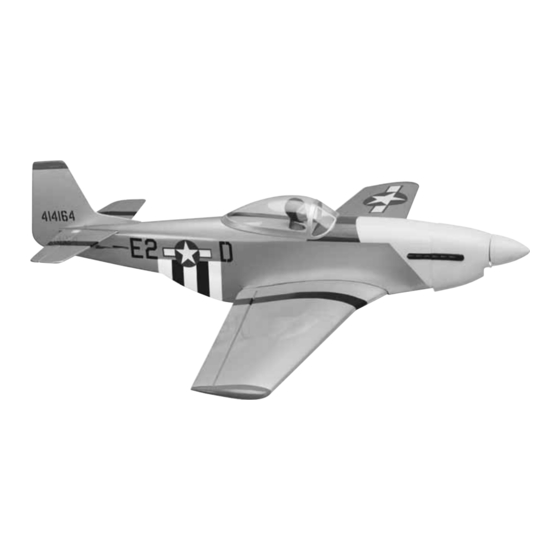GREAT PLANES COMBAT MUSTANG Combat P-51 ARF Buku Petunjuk - Halaman 18
Jelajahi secara online atau unduh pdf Buku Petunjuk untuk Mainan GREAT PLANES COMBAT MUSTANG Combat P-51 ARF. GREAT PLANES COMBAT MUSTANG Combat P-51 ARF 20 halaman.

6. Use thread-locking compound to secure critical
fasteners such as the set screws, screws that hold
the carburetor arm (if applicable), screw-lock
pushrod connectors, etc.
7. Make sure all hinges are securely glued in place.
8. Reinforce holes for wood screws with thin CA where
appropriate (servo mounting screws, cowl mounting
screws, etc.).
9. Confirm that all controls operate in the correct direction
and the throws are set up according to the manual.
10. Make sure there are silicone retainers on all the
clevises and that all servo arms are secured to the
servos with the screws included with your radio.
11. Secure connections between servo wires and
Y-connectors
or
connection between your battery pack and the on/off
switch with vinyl tape, heat-shrink tubing or special
clips suitable for that purpose.
12. Make sure any servo extension cords you may have
used do not interfere with other systems (servo arms,
pushrods, etc.).
13. Make sure the fuel lines are connected and are
not kinked.
14. Balance your propeller (and spare propellers).
15. Tighten the propeller nut and spinner.
16. Place your name, address, AMA number and
telephone number on or inside your model.
17. Cycle your receiver battery pack (if necessary) and
make sure it is fully charged.
18. If you wish to photograph your model, do so before
your first flight.
19. Range check your radio when you get to the flying field.
FLYING
Mount the Wing to the Fuselage
The Combat P-51 ARF is a great-flying model that flies
smoothly and predictably. The Combat P-51 ARF does
not, however, possess the self-recovery characteristics of
a primary R/C trainer and should be flown only by
experienced R/C pilots.
Fuel Mixture Adjustments
A fully cowled engine may run at a higher temperature than
an un-cowled engine. For this reason, the fuel mixture
should be richened so the engine runs at about 200 RPM
below peak speed. By running the engine slightly rich, you
will help prevent dead-stick landings caused by overheating.
servo
extensions,
and
CAUTION (THIS APPLIES TO ALL R/C AIRPLANES): If,
while flying, you notice an alarming or unusual sound
such as a low-pitched "buzz," this may indicate control
surface flutter . Flutter occurs when a control surface
(such as an aileron or elevator) or a flying surface (such
as a wing or stab) rapidly vibrates up and down (thus
causing the noise). In extreme cases, if not detected
immediately, flutter can actually cause the control surface
to detach or the flying surface to fail, thus causing loss of
control followed by an impending crash. The best thing to
do when flutter is detected is to slow the model
immediately by reducing power, then land as soon as
safely possible. Identify which surface fluttered (so the
problem may be resolved) by checking all the servo
the
grommets for deterioration or signs of vibration. Make
certain all pushrod linkages are secure and free of play. If
it fluttered once, under similar circumstances it will
probably flutter again unless the problem is fixed. Some
things which can cause flutter are; Excessive hinge gap;
Not mounting control horns solidly; Poor fit of clevis pin in
horn; Side-play of wire pushrods caused by large bends;
Excessive free play in servo gears; Insecure servo
mounting; and one of the most prevalent causes of flutter,
Flying an over-powered model at excessive speeds.
Hand Launching
For the first flight it is recommended that you get someone
experienced in hand launching models. Set your model on a
bench, off of the ground. Start the engine and make all
needed adjustments holding the plane on the bench.
Carefully carry the plane to the area of your flying field you
intend to launch the plane from.
Have an assistant hold the plane from the radiator scoop
and wing tip. Holding the plane level and pointing into the
wind, run a few steps and allow the plane to fly out of your
hand. There should not be a reason to actually throw the
plane. In fact, throwing the plane can be more difficult than
letting the plane fly out of your hand. Be smooth on the
elevator stick, allowing the model to establish a gentle climb
to a safe altitude before turning into the traffic pattern.
For reassurance and to keep an eye on other traffic, it is a
good idea to have an assistant on the flight line with you. Tell
him to remind you to throttle back once the plane gets to a
comfortable altitude.
Take it easy with the Combat P-51 ARF for the first few
flights, gradually getting acquainted with it as you gain
confidence. Adjust the trims to maintain straight and level
flight. After flying around for a while, and while still at a safe
altitude with plenty of fuel, practice slow flight and execute
practice landing approaches by reducing the throttle to see
18
